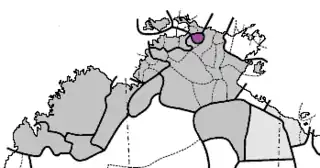| Giimbiyu | |
|---|---|
| Mangerr | |
| Native to | Australia |
| Region | Northern Territory |
| Extinct | 1980s–1990s[1] |
Language isolate or Arnhem Land?
| |
| Dialects |
|
| Latin (Australian Aboriginal) | |
| Language codes | |
| ISO 639-3 | Variously:zme – Mangerrurc – Urninganggerr – Erre |
| Glottolog | giim1238 |
| AIATSIS[2] | N220 |
| ELP | |
 Giimbiyu (purple), among other non-Pama-Nyungan languages (grey) | |
Giimbiyu is an extinct Aboriginal Australian language isolate once spoken by the Giimbiyu people of northern Australia.
The name Giimbiyu is a Gaagudju word for 'of the stoney country'. It was introduced in Harvey (1992) as a cover term for the named dialects,[2]
- Mangerr (Mengerrdji)
- Urningangga (Wuningak) and Erri (Arri)
In 1997 Nicholas Evans proposed an Arnhem Land family that includes the Giimbiyu languages. However, they are not included in Bowern (2011).[3]
Phonology
Consonants
| Peripheral | Laminal | Apical | ||||
|---|---|---|---|---|---|---|
| Labial | Velar | Palatal | Alveolar | Retroflex | ||
| Plosive | p | k | ɟ | t | ʈ | |
| Nasal | m | ŋ | ɲ | n | ɳ | |
| Fricative | ɣ | |||||
| Tap | ɾ | |||||
| Lateral | ʎ | l | ɭ | ɭʲ | ||
| Approximant | w | j | ɻ | |||
- Coarticulation among consonants is also present.
- Among consonant-coarticulation, /ɣ/ when preceding sounds /l, ɾ/ may result in being heard as a voiceless palatal [ç].
Vowels
| Front | Back | ||
|---|---|---|---|
| High | ɪ | u | |
| Mid | ɛ | ø | |
| Low | a | ||
- /u/ may also be heard as [o].
- Coarticulation among a preceding /ɪ/, may result in the vowel sound becoming more central [ɪ̈] or as a diphthong [ɪə].[4]
Vocabulary
Capell (1942) lists the following basic vocabulary items:[5]
gloss Mangeri Uningangk man wurilg wurig woman ŋeːn ŋeːn head wiliŋerm ulŋerb eye iːm iːm nose jingolm ingolb mouth jagir indjaːd tongue nindjadj indjaːd stomach abeɽweɽe abeɽwe bone ijerm mulgud blood maneŋulm waija kangaroo oidjbaɣar wurulamb opossum muŋaːd malijarŋ emu wiwijüw iwidjiw crow gagud gagud fly muɳimuɳi maŋanaŋaɳ sun muɣaːliŋ indjuwawi moon järagäl järagäl fire wiɽumgarm widjälim smoke wuŋɛŋg wuŋɛŋg water ogog ogog
References
- ↑ Mangerr at Ethnologue (25th ed., 2022)

Urningangg at Ethnologue (25th ed., 2022)
Erre at Ethnologue (25th ed., 2022)
- 1 2 N220 Giimbiyu at the Australian Indigenous Languages Database, Australian Institute of Aboriginal and Torres Strait Islander Studies
- ↑ Bowern, Claire. 2011. "How Many Languages Were Spoken in Australia?", Anggarrgoon: Australian languages on the web, December 23, 2011 (corrected February 6, 2012)
- ↑ Birch, Bruce (2006). A first dictionary of Erre, Mengerrdji and Urningangk: three languages from the Alligator Rivers Region of North Western Arnhem Land, Northern Territory. Gundjeihmi Aboriginal Corporation: Jabiru: Gundjeihmi Aboriginal Corp.
- ↑ Capell, Arthur. 1941-1942, 1942-1943. Languages of Arnhem Land, North Australia. Oceania 12: 364-392, 13: 24-51.
Wiktionary has a word list at Appendix:North Australian word lists
- McConvell, Patrick and Nicholas Evans. (eds.) 1997. Archaeology and Linguistics: Global Perspectives on Ancient Australia. Melbourne: Oxford University Press
This article is issued from Wikipedia. The text is licensed under Creative Commons - Attribution - Sharealike. Additional terms may apply for the media files.